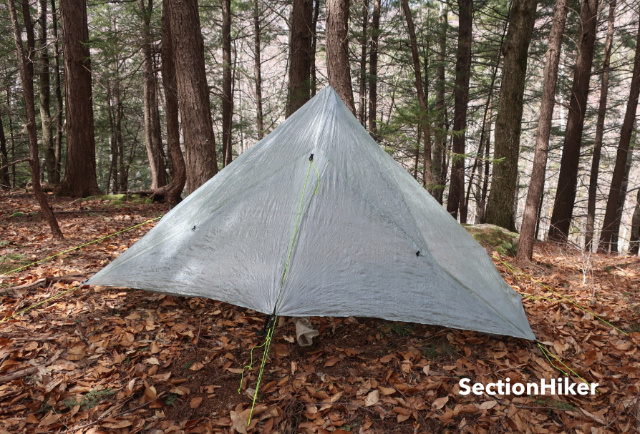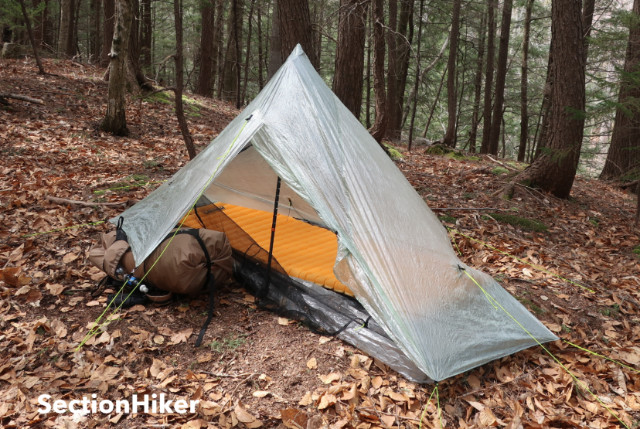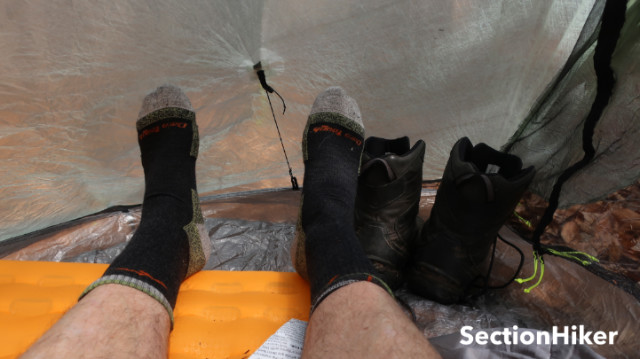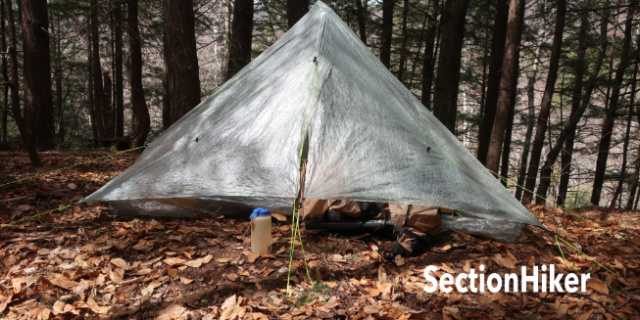The Zpacks Plex Solo is an ultralight one-person, single-wall tent made with Dyneema DCF that weighs just 13.9 oz. Retailing for $599, it has a hybrid pyramid shape and comes with a built-in bathtub floor, insect netting, and a front vestibule. A 52″ trekking pole or tent pole (sold separately) is required to set it up along with six to ten tent stakes. The interior is spacious with plenty of room to sit up and there is extra room for internal gear storage. It’s a good backpacking tent for use in moderate weather conditions but can require a fair amount of tweaking to get a taut pitch.
Specs at a Glance
- Type: Single-wall, non-freestanding
- Capacity: 1 person
- Weight: 13.9 oz / 395 g
- Poles: 1 trekking pole (not included)
- Peak-height: 52″
- Doors: 1
- Vestibule: 1
- Pockets: 1
- Dimensions: 7.5 feet long, 38″ wide in the center, 28″ wide at the ends
- Minimum number of stakes to pitch: 6 (10 recommended)
- Materials: 0.55 oz sq/yd DCF (Fly), 1.0 oz sq/yd DCF (Floor)
- Hydrostatic head: Fly (15,000 mm); Floor (20,000 mm)
- Packed dimensions: 6″ diameter x 12″ length (5.6L)
- Warranty: two-year limited warranty against defects in materials or workmanship
- Made in the USA
Tent Construction
The Zpacks Plex Solo is made using Dyneema DCF, an ultralight but very strong waterproof material that has very little stretch, even when wet. There are two grades of DCF used on the Plex Solo: the floor is made with 1.0 oz/sq yard DCF while the fly is available in two different weights depending on your choice of color: 0.55 oz sq yard DCF (blue, olive drab, white) or 0.75 oz sq yard DCF (burnt orange dirt, spruce green). Note: the weight of the tent increases to 15.4 oz if the 0.75 oz sq yard DCF is used. Both of these options are highly waterproof, exceeding conventional silnylon, silpoly, or PU-coated tents by a factor of five or more.
The tent seams on the Plex Solo are sewn for strength and factory seam taped to be waterproof. The tent also comes fully configured with bright yellow 2.0mm Dyneema Z-Line cord guylines and LineLoc V guyline tensioners, which eliminate the need to tie any knots. A DCF stuff sack is included with the tent. There isn’t a footprint for this tent specifically nor is one really required unless you camp regularly on highly abrasive ground. Zpacks sells DCF Groundsheets (3.1 oz) and Tyvek Groundsheets (9.2 oz), but you’ll find that their Tyvek groundsheet weighs almost as much as the tent! If you want a footprint that is lightweight and affordable we suggest using plastic window wrap which will weigh approximately 2 oz for this tent.
Plex Solo Tent Design Walkthrough

The Zpacks Plex Solo is best described as a pyramid-shaped monopole tarptent with a floating bathtub floor that is connected to the rain fly with loose insect netting. This type of construction is adaptable to uneven ground and annoying roots and rocks because the bathtub floor can move up or down independent of the walls to adapt to the surface contour. If you also have a thick inflatable sleeping pad, you can often turn a bumpy campsite into something more tolerable for sleeping.
The Plex Solo requires one 52″ (132 cm) trekking pole to set up, which is on the long side as trekking poles go. My trekking poles are just barely long enough when fully extended (way past their recommended length). You might need to upgrade your poles to use the Plex Solo or to use a pole jack (sold separately) to make the pole longer. But you best check your trekking pole length if considering this tent.
While you can set up the Plex Solo up with a minimum of six tent stakes, I’d recommend using all ten guylines to maximize the interior volume. It’s best to stake out the end corners and rear of the Plex Solo first, leaving lots of slack in the lines, which you can tighten once the trekking pole is inserted in the peak. When you insert your trekking pole, keep the grip on top because the peak, while reinforced, does not have a grommet inside to accommodate a carbide tip and would probably be punctured if you use the sharp end. Having done this with other tents, this is something you want to avoid.

With the vestibule doors closed and staked out, stake out the remaining guylines and tension them. You’ll find that rolling back one or both the vestibule doors or tensioning the bathtub floor inside the tent can ruin your wonderfully taut initial setup. This is an artifact of the tent’s asymmetric design.
For example, I might tweak a guyline cord or roll open the vestibule only to find that I’ve introduced significant slack in the back wall. I’ve owned several one-person Zpacks tents and this is something that I’ve always found frustrating with them. It’s one of the tradeoffs of using an asymmetric design that’s designed for minimal weight since adding more material or structural elements would make the shelter heavier. I liken it to owning a Jaguar motor car: it’s fast and fun to drive, but has a few idiosyncrasies that you were unaware of when you bought it.

The front vestibule has two overlapping panels that connect to a two-pronged hook on the front guyline so each side can be rolled back independently. This makes it easier to block the wind on one side of the vestibule while keeping the other side open for ventilation. The use of the two-pronged hook instead of a zipper, improves the durability of the tent since zippers are a common point of failure.

The vestibule doors do not reach the ground in order to ventilate the tent and to reduce internal condensation. The overhang provides enough protection to prevent moderate rainfall and splashback from reaching the inside of the tent. In more extreme blowing rain, lowering the trekking pole may also help reduce splashback, but the rear walls will go slack and are just as likely to soak you with internal condensation. A better bet would be to prop up your backpack or rain jacket in the vestibule to block the rain.
Zpacks Plex Soo
Comfort
Ease of Setup
Weather Resistance
Durabilty
Weight
Packed Size
Astonishingly Ultralight
The Zpacks Plex Solo is a well-ventilated ultralight backpacking tent that's easy to setup with a single trekking pole. It has a spacious interior with a bathtub floor that provides good weather protection in 3-season weather. Fully seam-taped, it's Dyneema fabric is extremely waterproof and easy to repair.

The front of the tent behind the vestibule is all mesh with a rainbow-shaped doorway, which I personally like because it’s so simple, but it can be prone to zipper jams or failure because considerable tension is put onto the zipper when opening it or closing it. It’s best to grab the fabric at the end of the zipper with one hand to provide a temporary anchor when you open or close it.

The bathtub floor inside the tent is quite long (90″) with a center width of 38″ and a tapered head and foot-end width of 28″, with enough room to use a wide pad and store some of your gear inside with you. I’ve used the Plex Solo with a 77″ x 25″ inch inflatable pad and had extra room to spare.
The bathtub floor is 8″ deep, but generally lies flat at the bottom of the tent unless you tighten elastic cords that suspend it from the rear panels. These cords help angle the insect netting so condensation can run down the ceiling and drain through the netting, rather than dripping on the floor. However, if you pull them too tightly they will cause the rear wall of the tent to bow inwards.

Livability
The interior of the Plex Solo is surprisingly spacious. I’m 5′ 11″ and I can sit up comfortably inside. When lying down, I don’t find the space over my head to be overly confining, and my feet steer clear of the ceiling at the far end.

Ventilation and the airflow through the tent is good as long as you keep both, or at least one of the vestibule doors open. The vestibule is fairly narrow and won’t completely cover a large backpack. Alternatively, you can upgrade one of Zpacks waterproof Dyneema or Ultra backpacks to avoid carrying a sodden backpack the next day
The DCF walls of the Plex Solo are translucent and let a lot of light pass through the walls. If you’re concerned about privacy, I’d recommend getting the rainfly in 0.75 oz per sq/yd DCF instead of the 0.55 oz per sq/yd DCF because it’s less transparent. However, because they are translucent, the Plex Solo and other DCF tents can get uncomfortably warm inside in direct sunlight. While this can be an asset in colder weather, it can make the tent insufferably hot and impossible to use until the sun goes down.
Comparable Tents
| Make / Model | Material | Weight | Price |
|---|---|---|---|
| Zpacks Plex Solo | DCF | 13.9 oz / 395 g | $599 |
| Tarptent Aeon Li | DCF | 17 oz / 482 g | $569 |
| Gossamer Gear DCF One | DCF/Sil-PU Nylon | 15.3 oz / 433 g | $539 |
| Six Moon Designs Lunar Solo | SilPoly | 26 oz / 737 g | $250 |
| Tarptent Rainbow Li | DCF | 21.8 oz / 619 g | $649 |
| Gossamer Gear The One | Sil-PU Nylon | 17.7 oz / 503 g | $299 |
The Tarptent Aeon Li is a one-person DCF shelter with a side door and vestibule like the Plex Solo. It has a lower peak height and a smaller interior but can be pitched with a regular-length trekking pole. It’s slightly heavier than the Plex Solo because it includes additional carbon-fiber struts in the corners that make it easier to achieve a perfectly taught pitch every time. Read our Aeon Li review.
The Six Moon Designs Lunar Solo is quite similar in design to the Plex Solo and makes an interesting counterpoint because it’s twice as heavy but less than half the cost. It’s made with low-stretch siliconized polyester (silpoly) that shares one of Dyneema’s most quoted benefits. Read our Lunar Solo review.
The Gossamer Gear “The One” is basically a Sil/PU Nylon version of the DCF One. While it is only a few ounces heavier than the Plex Solo, it is also half the price. Read our “The One” review.
The Gossamer Gear DCF One is a one-person tent with a DCF rain fly and a Sil/PU coated nylon floor that makes it more compact to pack than an all-DCF tent. It has a spacious front vestibule and requires two trekking poles to set up. It’s well-ventilated and easy to pitch but has slightly less internal space than the Plex Solo. Unfortunately, it’s been out of stock for over a year and it’s not clear if it will be available ever again. Read our DCF One review.

Recommendation
The Zpacks Plex Solo is the lightest weight tent Zpacks makes and at 13.9 oz, you’ll be hard-pressed to find an insect-proof shelter that’s lighter weight unless you switch to a tarp and a bivy sack. You may be tempted to buy the Plex Solo simply because it is so lightweight and I wouldn’t blame you, because I’ve done the same.
But, I’d still encourage you to consider the pros and cons of this shelter carefully. While it has a relatively spacious interior, it requires a long trekking pole (or pole jack) to pitch and has a fairly narrow vestibule that may not completely protect your backpack from the rain. It is a single-wall shelter and therefore prone to internal condensation unless you keep the vestibule doors rolled back for maximum ventilation. Finally, the asymmetric design can make the pitch a little fussy to dial in if you like your tent to have drum-tight walls, but with a little practice, you’ll get the hang of it and understand how to pick tent sites that play to its strengths.
Zpacks donated a tent for this review.
Updated January 2023.
SectionHiker is reader-supported. We only make money if you purchase a product through our affiliate links. Help us continue to test and write unsponsored and independent gear reviews, beginner FAQs, and free hiking guides. SectionHiker.com Backpacking Gear Reviews and FAQs
SectionHiker.com Backpacking Gear Reviews and FAQs 
Philip – I have to say that the depth of detail included in your reviews plus your breadth of experience with other products makes your reviews really valuable. You imply that the plex solo is fussy to get set up right, which is why you recommend using all 10 stake out points. Is this because it lacks structural elements like the carbon fiber struts in the aeon li and the use of two poles in the DCF One?
Yes, I think that’s accurate. Dyneema provides good rigidity when it’s used in a perfectly symmetric design, like the Zpacks Duplex. But when you throw in asymmetry and have walls that have different lengths, it helps to add structural components, even if they’re just another treking pole. It reduces the degrees of freedom of the tent skin, but results in a more consistent and uniform pitch.
As an owner of one of these tents I can attest to the light weight and simplicity of its design. It is easy to pitch using the method shown on the web site. I have the XL and the added weight is negligible in exchange for the additional room inside. This tent does slope straight down from a single point, so ends can get crowded if you are long, like me.
My one complaint is that rain water will quite easily, and predictably, migrate from the dyneema tent to the mosquito netting and into the bathtub. The surface tension of the water keeps it attached to the tent where the mosquito netting is sewn and from there, into the mesh and inside. Its virtually impossible to stop all water from entering no matter how the tent is tensioned.
I think I have a solution and that is to attach a 2” skirt along the back wall. That would get the rain out and away from the mosquito netting sewn seam and allow it to drip off to the ground. Since I like to modify tents and have plenty of 360LSE tape, dcf fabric and dcf repair tape laying around this is a simple operation. But, if you won’t or can’t take the time to make this change, you may be dissatisfied with the tent.
That modification is something Z-Packs should consider doing on their own as that one problem is truly the only drawback I’ve found with this tent, when a single wall absolute minimalist but need bug protection tent is your choice.
Thanks Philip for another exacting and helpful review. Of note, I own the Duplex and the original Solplex, and have also owned the Altaplex and the Plexamid. In Yosemite thunderstorms, I’ve never had a problem with rain entering the tent, although I take a lot of time to pitch it taunt. I believe the design of the original Solplex allows for more ventilation then the Plexamid did, and less guy lines. However, the extra strut in the back allows for this. I love the Zpacks tents, and have had many others in my time. I would add importantly, to those deciding, that Dyneema tents do NOT sag in the rain or freezing temperatures, which makes a big difference.
I wonder why, since single walled tents are so prone to condensation unless doors are rolled open (and even then in typical aussie-nz conditions still experience it), the manufacturers dont offer versios without doors and just a rain shadow lip to stop rain fall on the mesh door. Zpacks usedto offer this in the original hex solo and solo plus, both with and without doors. I suspect they stopped because most people wanted the doors – but if spending the $ to shave grams one has to question the need for doors (they protect from rain but still get you wet when down due to condensation).
Thanks for this review Phil. It will serve well for anyone looking for a good UL solo tent.
Howsomever… $599. ($600.) for this single wall tent?
I own a Tarptent Notch Li for the same price but with a double wall and more interior head and foot room.
I think a backpacker going to UL tents needs to look first at DESIGN, then quality and finally “bang-for-the-buck”.
In my case I feel I got the best of all of these parameters since my Gen. 2 Notch Li was made in likely the world’s highest quality fabricator working with Dyneema – a Chinese company, no less.
But Notch 20″ head and foot width looks tight to me. I know it has large dual vestibules I just wish they had more of the space inside. I do also appreciate head and foot room don’t like crawling in/out or wetting sleeping bag foot end with condensation. Rainbow LI appeals more to me much wider and longer for similar weight although no inner liner.
I have the Zpacks Pocket Tarp/doors mated with a solo-plus bathtub floor. Weighs 10 oz. No insect netting, but I smear a little Deet on and try not to think about spiders. More versatile ,lighter weight, and more room.
The Deet will dissolve the DCF. I wouldn’t recommend using it.
I own one and love it. I personally take the carbon pole Zpacks has as well as my poles. I setup the tent with the pole and use my trekking poles on the sides to pull the head and foot end out more.
Hi Phillip….love your reviews. I was wondering if you could include a star rating for this tent-as you do with the Aeon Li. I used to own a zpacks Solplex and loved it but found it drafty and that my feet touched the ceiling when in my winter quilt leading to condensation (am a mere 5 ft 6). Has this problem been alleviated? It doesn’t seem like it to me as your feet look close to the roof. But this tent is actually avialable at the moment!
sure.
I own the plex solo I only use 8 stakes I take the two upper back lines down to one stake for the bathtub. I also swapped out the line to 1.3mm and shortened them a little bit about 6 inches off each line and installed two of the trekking pole cups. It took my weight down to 12.8 ounces and increased the space. I’m 6”1 so the extra space was nice now I have plenty of room.
I find the toggles difficult to reach (my arms are short) and hand to manipulate with cold fingers. I was wondering about magnets but Joe kindly answered with this thoughtful reply of his research:
“I recently tested out magnets on my tent’s door closure. They work fine for rolling up the doors, but not for pinning the doors together in the center. The holding power isn’t strong enough, and strong wind would pop them apart easily- at least with the size I used.
I could try bigger magnets, but they do add weight, and there needs to be a balance between being able to pull them apart by hand, but not allowing the wind to shear them apart. The small neodymium magnets that I’ve been testing do also chip easily and can break when they slam together. I’m not sure how much I trust them.
If you just want to be able to roll up the doors w/magnets, that may be possible as a stick-on solution. That seems to work fine in testing.
I’m not sure what better solution there is than the toggle at the center. Zippers are heavy and failure prone. Any kind of clip probably wouldn’t be much different than the toggle. The good news is you don’t always need to use it, only when it is very windy.
Best Regards,
Joe Valesko”
You should add the Durston X-Mid Review to your table. Assuming you are thinking or reviewing the Pro 1 or Pro 2 as well at some point for comparison?
Curious, if you would you recommend this tent over the HMG Mid-1 — or vice versa (I get that the Altaplex is the HMG’s direct competitor)? While either tent is small as far as its footprint, do you find that pitching it [using the full compliment of stakes] takes up as much space as a much larger tent (e.g. X-Mid 1 Pro)? Do you find having a zipper on the HMG is an improvement (or not) over ZPack’s closure system? Thanks.
It really kind of depends on what the weather is where you plan to camp. Zpacks tents aren’t particularly good for very windy exposed conditions, at least not compared to other pyramid shelters. It also can takes a lot of stakes to get a good pitch with them – using the guylines to pull out the walls. Zpacks has put zippers on some of their tents which does help with weatherproofing, but its still not enough in a big blow. The Mid-1 is a perfectly good tent – and quite spacious, but if you want something really bombproof I would buy one of the pyramid tarps and a inner nest. That will be expensive though. Check out MLD’s mid offerings as well. I own an X-mid Pro which I plan to take to Scotland next year (very windy), but it also requires lots of extra guylines in wind, but is quite easy to pitch in forest with minimal stakes. I think you really need to decide/think about what conditions you plan to camp in – that more than any other actor will determine the tent you get or should get.